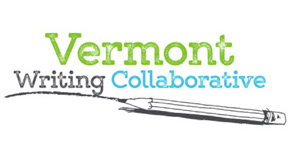What Is The “Painted Essay™”?
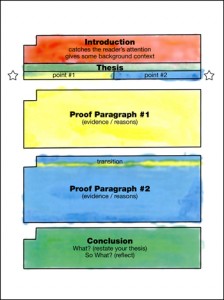
Download a PDF that gives a Painted Essay™ Lesson plan and Template
When we write, we are both constructing and communicating meaning about some body of knowledge or set of ideas. To be effective, a piece of writing must be a connected, coherent chunk of thought. When students are learning to write, there are several aspects of the process that may present difficulty.
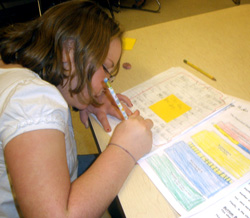
The first is knowledge. Students may be trying to write about something they really do not know very well. For example, a child who is trying to write an informational piece (a report) about Susan B. Anthony is not going to produce a successful piece of writing if her knowledge of Susan B. Anthony is sketchy or inaccurate.
Besides knowledge, students need a focus — a perspective through which to think about the information. An effective report does not simply give back information about Susan B. Anthony; rather, it synthesizes the information around a controlling idea, or focus. (“Susan B. Anthony worked for the vote for women” is a focus, while “Everything I know about Susan B. Anthony” is not.)
The second aspect of writing that may cause trouble for student writers is language. Even if they “know” what they are writing about (for example, fixing a broken bike chain), they may never have orally articulated that knowledge in words, or at least not with any fluency of language. With a lack of oral language about a subject, writing about the subject will be difficult.
The third aspect of writing that may challenge student writers is structure. Typically, young students have heard many stories, so they carry a “story structure model” in their heads. They have not typically, however, heard or read lots of articles or other chunks of informational writing. They do not carry “expository writing models” in their heads. When they come to write a report, they are frequently at a loss as to how to begin or how to build their writing.
This is where the painted essay comes in.
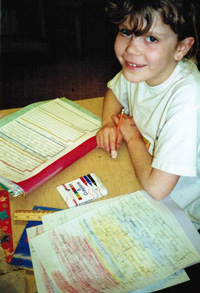
The painted essay was developed by Diana Leddy, a Vermont elementary teacher. It was based on the idea that students are visual learners, and need a very clear visual model of what informational writing actually looks like as a whole, complete chunk. The painted essay is a way of “seeing things whole”, as Stuart Little might put it. It uses a clear, patterned structure tied to certain colors so that students are able to use and internalize a template for thinking – and therefore, writing.
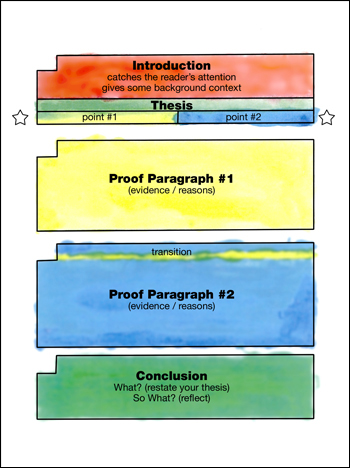
The painted essay is NOT meant to suggest that all expository/informational writing fits neatly into four paragraphs, or even that all informational writing should be built in a “statement/proof” structure. What the painted essay is, however, is a very flexible, easy-to-modify organizational structure that helps students to both think and write clearly.
The introduction is colored red because it needs to get the reader’s attention.
Next is the focus (controlling idea). It’s green for “Go this way!” Sometimes, the green is omitted for primary children. Point 1 is the “yellow” part of the (green) focus. Point 2 is the “blue” part of the (green) focus.
The yellow block is the first body paragraph. Since it supports the first part of the focus, all of its details are yellow.
The blue block is the second body paragraph. Since it supports the second part of the focus, all of its details are blue.
The conclusion comes lasts. Since it reminds the reader of the focus, and synthesizes the yellow and blue ideas again, it is green. It is both the “what” (here’s a reminder of my focus) and the “so what” (here’s a bit of reflection on or extension of that focus).
The Painted Essay is the most effective way I have seen to teach children to write. As a school, I think we will see such an improvement in writing because we are all using the same techniques and language. Consistency is the key. Because the Painted Essay uses color to help children understand the organization of expository writing, it will guide them in any writing situation. The color cues help the student not only understand the organizational patterns, but also the “jobs” of each part. I truly think that once children learn the pained essay format, it will free them up to bring out their creative side!
— Liv Perry, Librarian, Stowe Elementary
The Painted Essay format has provided me with a clear method and content to teach my fourth graders about writing. It is a clear and concise method of teaching students the proper format of expository writing…. Students are taught in a way that is visual, auditory, kinesthetic, and cognitively established for deeper levels of student understanding. It helps keep the students organized and on track.
— David Powell, Mater Christie School, Grade 4
